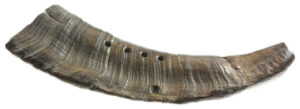There’s a couple of answers to this really, depending upon whether you stick to an instrument which had that particular name or whether you mean fingerhole instruments in general. Even today, there are different names used to describe this instrument in the UK and the USA. It hinges on the zero at the end: USA -cornetto, elsewhere - cornett. The instrument which carries the name appeared in the late 1400s but other instruments operating on the same principle are known from somewhat earlier.
While the cornett(o) is a reintroduction to the modern musical world, the bukkehorn, a fingerhole horn from Norway and Sweden, is a continuously-used instrument which is still in use in those countries. It was traditionally made from a ram’s horn and given three or four fingerholes. Such instruments from this area can be dated to the Iron-Age, suggesting that they have survived in this region for millennia.
There is no physical evidence for such instruments having existed in southern Europe but one text, written by Xenophon around the year 370 BCE, describes a meal he attends, having been invited by Seuthes, a powerful Tracian leader. In Book VII of the work, entitled Anabasis (Expedition), he describes the after-dinner entertainment thus:
After this, there came musicians blowing on horns such as they use in giving signals, and playing on trumpets of raw ox-hide not only measured notes, but music like that of a harp.
The phrase used, ‘music like that of a harp’ implies that they were playing melodies with notes outside the natural harmonic series, i.e., most probably by means of fingerholes.
The reference to ’trumpets of raw ox-hide’, (using the greek word ‘salpinx’) suggests that these might have been of wood and made in the manner of a mediaeval cornett, i.e., wood split in two halves and bound together with leather.
Image: A Typical Mediaeval Cornett(o)

